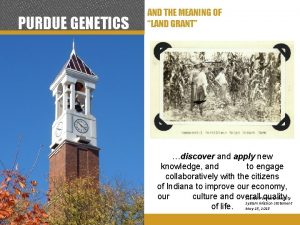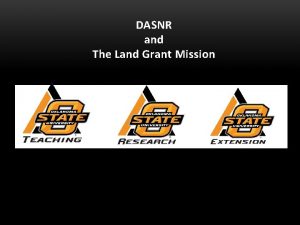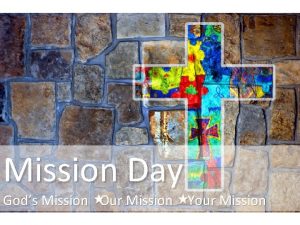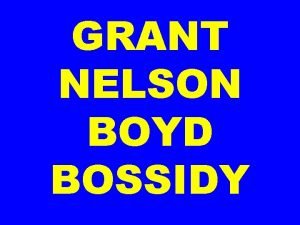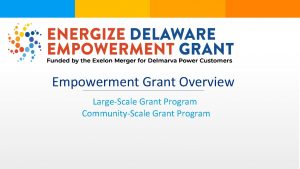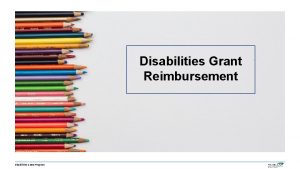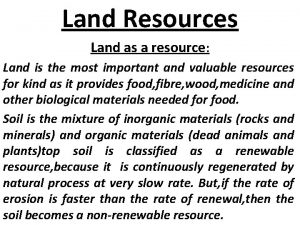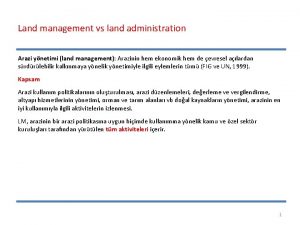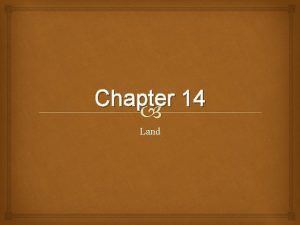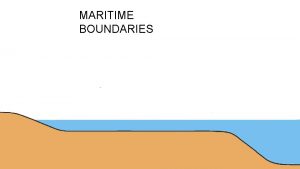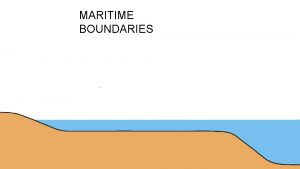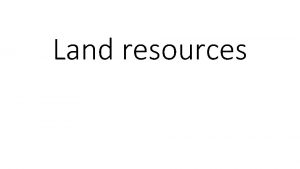The Land Grant Mission The Land Grant Mission





























- Slides: 29

The Land Grant Mission

The Land Grant Mission Is It Obsolete? Do we still meet 21 st Century Needs? n Have we become too Elitist? Do we still place value on investments in public education? n n n And, a little history!

Morrill Act of 1862 n n A bold new experiment – a Profound innovation The result was a “quiet revolution” The first social contract between this nation and her citizens Creation of “Peoples Colleges” “The Tipping Point – How Little Things Can Make a Big Difference” – Malcolm Gladwell

Higher Education prior to 1862 n n Elitist with a focus on Law, Theology, Medicine and Philosophy Available only to the “landed gentry” Education was a “state’s right” issue, not a federal matter Morrill Act – Created in the belief that American social and economic development was best served if higher education was made broadly available to all

The Morrill Act n n n Established a public, federally assisted system of higher education Congress chose not to use federal funds, but rather LAND (via the Homestead Act), to encourage states to participate Congress was cash short!

Hatch Act of 1887 n n n Created a research and experimentation effort focused in the public interest Divested and shared the research and discovery efforts with the states and their newly formed colleges Established the role of government in stimulating local or regional economic growth and development

Land Grant Acts of 1890 and 1994 n n Land Grant Act of 1890 provided funding for the 17 historically black land grant institutions Land Grant Act of 1994 conferred Land Grant status on the 29 Native American colleges as a provision of the Elementary and Secondary Education Reauthorization Act and authorizes the establishment of an endowment

Smith Lever Acts of 1914 n n Created out of a need to disseminate information for the public good Congress created a new funding mechanism that established a three-way partnership

The Central Theme n n n LGU’s have always broken with tradition and pursued the non-traditional Accessibility, research and discovery in the public interest, and engagement with stakeholder’s is our hallmark It’s what makes us different!

Challenges of the 21 st Centruy n n The LGU’s will remain a critical part of the educational landscape Can we recognize the challenges? n n n Funding Mission creep Inaccessibility Accountability Insufficient flexibility to respond rapidly to timely issues of the day

We’re really not a System! n n We do not make unified decisions Our Chancellors and Presidents really do not work together We’ve become stratified – The elite, elitism and the rest! And, we focus too much on rankings. YES, I said RANKINGS!

Nor are we a partnership! n What is a Partner? n n n One of a pair or team Associated with one another in a common activity Implies equality of activity. A relationship in which each person (association) has equal status and yet a certain independence An ally in a common cause How do we define the state / federal relationship and is it really a partnership?

Have we lost sight of our fundamental social responsibilities? n n n Are we still interested in measuring the impacts of meaningful social change? Are rankings more important than social change? Have we lost sight of the needs of the learner?

Public Good versus Private Benefits n n This issue lies at the heart of the problem, e. g. , those providing funds no longer look at or understand the concept of “public goods”. The contributions of the LGU are no longer viewed as impacting the public good.

The Ever-Changing Mission n What is our comparative advantage? Are we using it? With our network and outreach capacity, we have an unfair advantage, but do we use it effectively? How do we use it for determining priorities?

Rediscovering our Comparative Advantage n n What can we do best in light of 21 st Century realities? How do we create partnerships and collaborative arrangements to maximize efficiency? More multi-state partnerships. Does our traditional partnership still function? How do we persuade the general public that investments in higher education will result in payoffs that are worth accruing? That benefit society?

The Bottom Line n n n Are we addressing important stakeholder identified needs? Are we successful in the development of programs for new and / or nontraditional audiences? Are we accountable to stakeholders?

The Bottom Line n n n Can we document attitudinal, knowledge or behavioral change in targeted audiences? Are we building effective teams with collaborators on and off campus? Are we targeting niches where cooperative extension and the college can make unique contributions to problem solving?

The Bottom Line n n Are we achieving outcomes that are welldefined and specific to priority audiences? And most importantly…, Are we communicating the above effectively?

If we are to succeed Recommendations n n Find more opportunities to partner Let our constituents drive our programs Be a leader in the communities that we serve Identify more champions

Recommendations, cont. n n n Model and communicate successful examples of collaboration Nothing builds success like showcasing the positives Reorganize so we can better serve our stakeholders

So, Are We Relevant? Of course we are! Have we lost our way, to a degree – YES n Can we adapt – YES n n

So, What is Our Next Challenge? n n We must reemphasize the need to be nontraditional, but in a 21 st Century context Reaffirm our principles of n n n Accessibility A practical as well as classical education Research and discovery in the public interest Connectedness with the public And, learn to “Think outside the box”

Selected Readings n Reports of the Kellogg Commission on the Future of State and Land-Grant Universities n n The Engaged Institution (3 rd Rept) A Learning Society (4 th Rept) Renewing the Covenant (6 th Rept) The Land Grant Tradition – A NASULGC Report November 2000

THANK YOU www. agnr. umd. edu/users/nera email: tfretz@umd. edu


The President’s ’ 07 Budget n n n Hatch funding would be reduced by 35% in FY 07 and further reduced to 55% of the base by FY 2011 Mc. Intire-Stennis (forestry) funding would be reduced by 59% in FY 07 and funds placed in a competitive portfolio Animal Health and Disease (Section 1344) would be eliminated in FY 07

FY 07 Impacts n n Loss of several hundred research programs and projects Potential loss of numerous multidisciplinary teams and efforts Loss of infrastructure, e. g. , farms and field stations Reductions in operational funds

FY 07 Impacts n n State matches could be at risk Significant losses in current faculty and staff research capacity Program reductions and eliminations Significant losses in graduate student support
 Purdue land grant
Purdue land grant An area of land largely enclosed by higher land
An area of land largely enclosed by higher land High rocky land usually with steep sides
High rocky land usually with steep sides Hệ hô hấp
Hệ hô hấp Công thức tiính động năng
Công thức tiính động năng Bảng số nguyên tố
Bảng số nguyên tố đặc điểm cơ thể của người tối cổ
đặc điểm cơ thể của người tối cổ Tỉ lệ cơ thể trẻ em
Tỉ lệ cơ thể trẻ em Các châu lục và đại dương trên thế giới
Các châu lục và đại dương trên thế giới ưu thế lai là gì
ưu thế lai là gì Thẻ vin
Thẻ vin Các môn thể thao bắt đầu bằng tiếng nhảy
Các môn thể thao bắt đầu bằng tiếng nhảy Tư thế ngồi viết
Tư thế ngồi viết Bàn tay mà dây bẩn
Bàn tay mà dây bẩn Hát kết hợp bộ gõ cơ thể
Hát kết hợp bộ gõ cơ thể Mật thư tọa độ 5x5
Mật thư tọa độ 5x5 Từ ngữ thể hiện lòng nhân hậu
Từ ngữ thể hiện lòng nhân hậu Tư thế ngồi viết
Tư thế ngồi viết Trời xanh đây là của chúng ta thể thơ
Trời xanh đây là của chúng ta thể thơ V. c c
V. c c Gấu đi như thế nào
Gấu đi như thế nào Thể thơ truyền thống
Thể thơ truyền thống Khi nào hổ con có thể sống độc lập
Khi nào hổ con có thể sống độc lập Thế nào là hệ số cao nhất
Thế nào là hệ số cao nhất Diễn thế sinh thái là
Diễn thế sinh thái là Vẽ hình chiếu vuông góc của vật thể sau
Vẽ hình chiếu vuông góc của vật thể sau Lp html
Lp html Làm thế nào để 102-1=99
Làm thế nào để 102-1=99 Thế nào là mạng điện lắp đặt kiểu nổi
Thế nào là mạng điện lắp đặt kiểu nổi Lời thề hippocrates
Lời thề hippocrates
